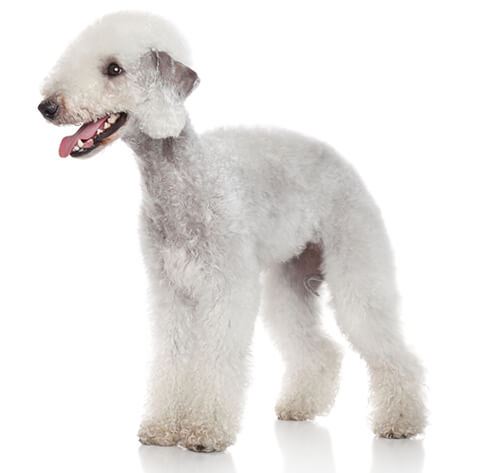
A hardy breed known for his curly, woolly coat, the Bedlington Terrier was developed in 19th-century England to catch vermin. His gracefully shaped body gives the Bedlington the capacity for great speed and endurance. Mild and gentle with a lovable nature, the breed makes a wonderful family companion. He is an energetic but not overly rambunctious companion that needs daily exercise. His coat requires regular trimming.
DID YOU KNOW? The Bedlington Terrier was popular with John D. Rockefeller and his family. The Bedlington, named “Timmie,” who won the 1948 Westminster Kennel Club Dog Show was owned by Rockefeller's grandnephew, William A. Rockefeller.
ALSO KNOWN AS: Rothbury Terrier, Rodberg, Rothbury's Lamb
The need-to-know
- Dog suitable for owners with some experience
- Extra training required
- Enjoys active walks
- Enjoys walking one to two hours a day
- Large dog
- Minimum drool
- Requires grooming every other day
- Hypoallergenic breed
- Quiet dog
- Guard dog. Barks and alerts
- May require training to live with other pets
- May require training to live with kids
Personality

The Bedlington is affectionate and full of fun, being loyal and gentle to their owners. They are however very much a typical terrier, and can be rather reactive as well as acting as an effective watchdog, being quite courageous once roused. In general, they will be fairly placid if they are receiving a regular amount of mental and physical stimulation.
History and Origins

Country of Origin: England
Originally bred from a combination of local terriers, with an outcross to both Whippets and Dandie Dinmonts, workers in the Rothbury area of Northumberland developed the Bedlington Terrier in the 18th century. A little like a wolf in sheep’s clothing, the gentle appearance of the Bedlington Terrier was rather at odds with their tough working natures, and they developed a reputation as a killer of vermin, a poacher's sidekick and a fighter.They entered the show ring in 1870 and since then their appearance and their natures have changed to give us the dog we have today.
Nutrition and Feeding

Small dogs have a fast metabolism, meaning they burn energy at a high rate, although their small stomachs mean that they must eat little and often. Small-breed foods are specifically designed with appropriate levels of key nutrients and smaller kibble sizes to suit smaller mouths. This also encourages chewing and improves digestion.
Exercise

The Bedlington Terrier needs at least an hour's daily exercise ideally more. They excel in games that involve running, jumping and retrieval - including agility. They must be kept mentally stimulated to avoid behavioural problems developing that arise from boredom or frustration.
Other Information

Health and common issues
The Bedlington Terrier can suffer from an inherited liver disease ('copper storage disease'). A DNA test is available, and so all breeding dogs should be tested. As with many other breeds, they can also suffer hereditary eye disorders and so eye testing of breeding dogs is recommended. The breed club monitor the health of the breed carefully and should be contacted for the most up-to-date information and details of any DNA or additional testing they recommend. Breed Clubs can be found on the Kennel Club website.
Space requirements
The Bedlington Terrier does not need much space at all - but they do need access to open safe places to get all the daily exercise they need.
Training bedlington terriers
Bedlington Terriers are surprisingly trainable - especially in sports such as agility where they can excel - and this helps to keep their busy minds and bodies occupied. Early and ongoing socialisation is needed as they can be unfriendly with other dogs. A good recall is essential to prevent them from getting into trouble chasing squirrels or rabbits, and they do need a lot of time and patience to train them to live with cats. They may never be reliable with strange cats or small animals.
Best family dog breeds
Bedlington Terriers can make good family dogs but like many terriers they can get overly aroused by rough or noisy games so are better in families with older sensible children. While many dogs are traditionally thought of as being good with children, all dogs and children need to be taught to get on with and respect each other, and be safe together. Even so, dogs and young children should never be left alone together and adults should supervise all interactions between them.
Did you know?
- Originally there were two different types of Bedlington Terrier - the ones that made use of the Whippet to give them longer legs designed for chasing rabbits and hare-coursing, and the ones that used the Dandie Dinmont Terrier to give them shorter legs for going to ground. Now the Bedlington is a mixture of both.
- Bedlington Terriers used to be known as ‘Gypsy Dogs’ as they were used by Romanies for poaching.
- They’re often referred to as ‘the smartest and quickest’ of the terrier breeds.
- The first ever Bedlington Terrier was called Piper and was said to still be hunting at the grand age of 14, despite being nearly blind and toothless.